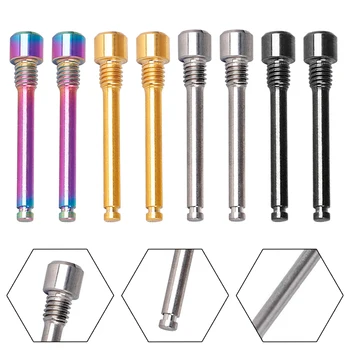Fair Shine industrial (Hong Kong) Co., Limited
To provide customers with the most comprehensive precision mold parts solutions.

2024-11-01 19:26:53
Pin Inserts are precision metal parts used in connectors, circuit boards or other electronic devices. They are made of high-quality metal materials (such as brass, phosphor bronze, stainless steel, etc.) to ensure good conductivity and mechanical properties.
The manufacturing process mainly includes precision turning, stamping, Injection Molding and other methods, depending on the shape, size and purpose of the pin.

Precision turning: The metal material is cut by a high-precision lathe to obtain the required shape and size. This method is suitable for manufacturing pins with complex shapes and high precision requirements.
Stamping: The metal sheet is stamped and formed using a mold, which is suitable for mass production of pins with simple shapes and consistent sizes.
Injection Molding: The molten metal or plastic is injected into the mold, and the pin of the desired shape is obtained after cooling. This method is suitable for manufacturing pins with complex shapes and low dimensional accuracy requirements.
The precision and thickness of Pin Inserts are its important performance indicators, which directly affect its performance and reliability in electronic equipment.
Precision: The tolerance requirements of Pin Inserts are usually very strict, generally between ±0.001~±0.0005 mm. This ensures that the pin can be accurately inserted into the socket in the connector or circuit board, thus achieving a good electrical connection.
Thickness: The thickness of Pin Inserts depends on its purpose and the required mechanical strength. Generally speaking, the thicker the thickness of the pin, the higher its mechanical strength, but it will also increase the difficulty and cost of insertion. Therefore, when designing the pin, it is necessary to determine the appropriate thickness according to the specific application scenario and needs.
Pin Inserts have a variety of characteristics, which make them play an important role in various electronic devices:
Good conductivity: Since the pin is usually made of high-quality metal materials, it has good conductivity and can ensure signal transmission and current flow in electronic devices.
High precision: The tolerance requirements of the pin are very strict, ensuring its precise connection and stable performance in electronic devices.
Corrosion resistance: The surface of the pin is usually specially treated to improve its corrosion resistance and thus extend its service life.
Easy processing: The pin can be processed and manufactured through a variety of processes, suitable for different shapes, sizes and uses.
Customizable: The pin can be customized according to customer needs, including customization in materials, shapes, sizes, coatings, etc.
Pin Inserts have a wide range of applications in multiple fields. The following are its main application areas:
Electronic connectors: Pin Inserts are an important part of electronic connectors and are used to achieve electrical connections between electronic devices. They can be inserted into the jacks of the connector to form a reliable electrical connection.
Circuit boards: On circuit boards, Pin Inserts are used to connect different electronic components and assemblies. They can be inserted into the jacks on the circuit board and fixed by welding or other means to achieve connections between circuits.
Communication equipment: In communication equipment, Pin Inserts are used to achieve electrical connections between different components. They can be inserted into the jacks of the connector to ensure signal transmission and communication stability.
Automobile: In the automotive industry, Pin Inserts are used to connect various components and assemblies of the car. They can be inserted into the jacks of the connector to ensure the normal operation and safety of the car circuit.
Aerospace: In the aerospace field, Pin Inserts are used to connect various components and assemblies of the aircraft. They need to withstand extreme environments such as high temperature and high pressure, so they are usually made of high-strength and corrosion-resistant metal materials.
FAQ
How to ensure accurate positioning when installing Pin Inserts?
When installing Pin Inserts, you can use positioning tools or clamps to ensure that they are in the correct position and perpendicular to the substrate. At the same time, it is recommended to mark the position before installation to improve accuracy.
Why do Pin Inserts loosen during use?
Pin Inserts loosening may be due to improper installation, material fatigue or excessive mechanical stress. It is recommended to check the installation method and ensure that the appropriate material and size are used to avoid excessive load.
How to choose the right size of Pin Inserts?
The selection of the right size of Pin Inserts should be based on the diameter, depth and application requirements of the hole. Ensure that there is a proper fit when inserting. Too loose or too tight will affect performance.
How does the material of Pin Inserts affect performance?
The material of Pin Inserts affects its corrosion resistance, strength and durability. Choose materials suitable for specific application environments, such as stainless steel, aluminum or plastic, to meet performance requirements.
How to clean and maintain Pin Inserts?
When cleaning Pin Inserts, it is recommended to use a mild detergent and a soft brush, and avoid using highly abrasive materials. Check the condition of the Pin Inserts regularly to ensure there is no damage or corrosion to extend their service life.

Fair Shine industrial (Hong Kong) Co., Limited
To provide customers with the most comprehensive precision mold parts solutions.
+86 189 2682 6341
Block 1, No. 12, Wusong 4th Street, Yuwu Industrial Zone, Dongcheng District, Dongguan, Guangdong, China
Copyright © 2025 Dongguan Huixiang Mold Technology Co., Ltd all rights reservrd.
Technical support: HuaShang